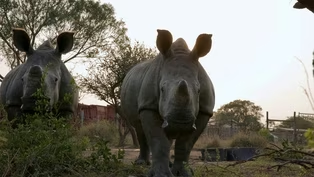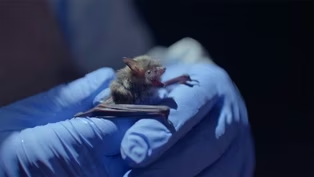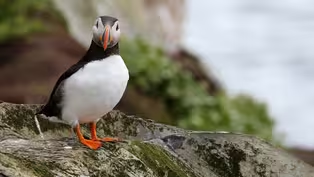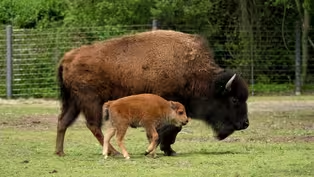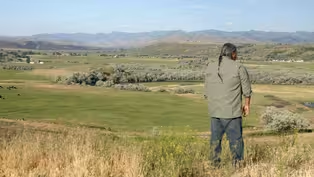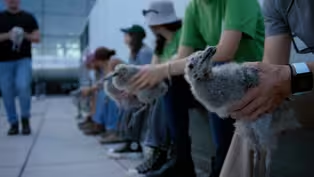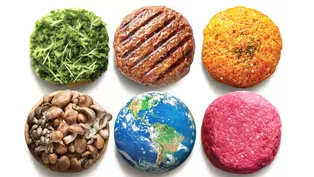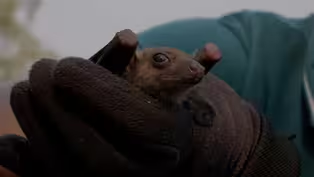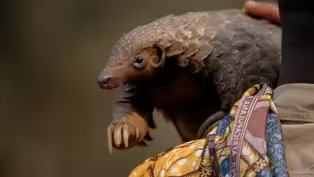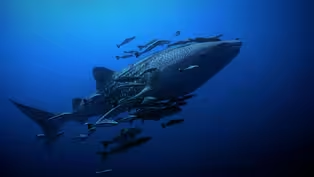
Turtle Trackers | WILD HOPE
Special | 11m 27sVideo has Closed Captions
Researchers track the “Lost Years” of leatherback sea turtles.
Three species of sea turtles nesting in southeast Florida face a range of manmade threats. Thanks to conservation measures, loggerhead and green sea turtles are recovering, but leatherbacks remain at risk. Researchers know little about this amazing species — and in the battle to save leatherbacks, knowledge is key.
Problems playing video? | Closed Captioning Feedback
Problems playing video? | Closed Captioning Feedback
Major support for NATURE is provided by The Arnhold Family in memory of Henry and Clarisse Arnhold, Sue and Edgar Wachenheim III, The Fairweather Foundation, Charles Rosenblum, Kathy Chiao and...

Turtle Trackers | WILD HOPE
Special | 11m 27sVideo has Closed Captions
Three species of sea turtles nesting in southeast Florida face a range of manmade threats. Thanks to conservation measures, loggerhead and green sea turtles are recovering, but leatherbacks remain at risk. Researchers know little about this amazing species — and in the battle to save leatherbacks, knowledge is key.
Problems playing video? | Closed Captioning Feedback
How to Watch Nature
Nature is available to stream on pbs.org and the free PBS App, available on iPhone, Apple TV, Android TV, Android smartphones, Amazon Fire TV, Amazon Fire Tablet, Roku, Samsung Smart TV, and Vizio.
Buy Now
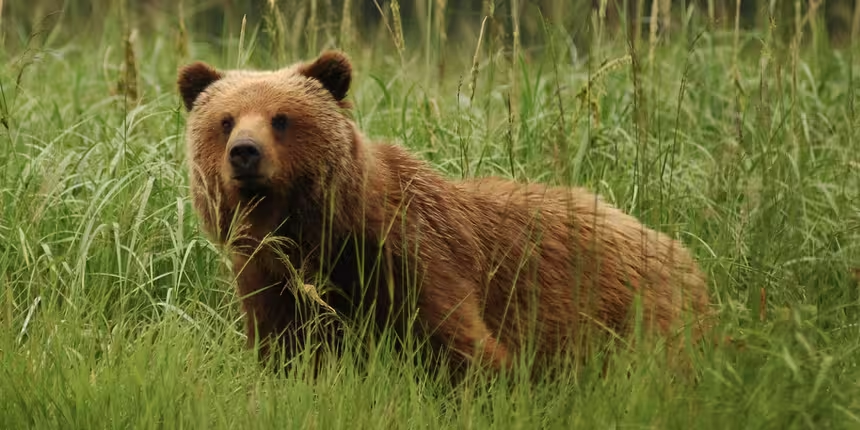
Explore More Ways to Watch
Bring the beauty and wonders of wildlife and natural history into your home with classic NATURE episodes.Providing Support for PBS.org
Learn Moreabout PBS online sponsorshipMore from This Collection
WILD HOPE is a new series of short films that highlights the intrepid changemakers who are restoring our wild places and sparking new hope for the future of our planet.
Video has Closed Captions
How does a densely populated nation like Singapore transform into a lush green oasis? (14m 51s)
Video has Closed Captions
For decades, rhinos have been the face of poaching. (16m 28s)
Video has Closed Captions
As a deadly fungus devastates North America’s bats, scientists are testing new ways to save them. (14m 47s)
Video has Closed Captions
In the Westman Islands, one community has banded together to save lost young puffins. (13m 15s)
Video has Closed Captions
Sixty million American bison once thundered across the prairies of North America. (18m 52s)
Reclaiming Bear River | WILD HOPE
Video has Closed Captions
The Bear River was once a lush area with wetlands, hot springs, and abundant wildlife. (17m 25s)
Building for Birds | WILD HOPE
Video has Closed Captions
Millions of migrating birds pass through our yards, but glass windows pose a deadly threat. (16m 3s)
Mission Impossible | WILD HOPE
Video has Closed Captions
Meet the genius behind the plant-based Impossible Burger. (39m 41s)
Pangolin Protectors | WILD HOPE
Video has Closed Captions
Due to the demand for their scales, pangolins are the most trafficked animal in the world. (12m 24s)
Way of the Elephants | WILD HOPE
Video has Closed Captions
Elephant migration corridors in India are a necessary thoroughfare for one of the largest animals. (15m 11s)
Whale Shark Homecoming | WILD HOPE
Video has Closed Captions
A renowned spiritual leader is inspiring fishermen to become guardians of the world’s biggest fish. (16m 49s)
Providing Support for PBS.org
Learn Moreabout PBS online sponsorship♪ (water splashing) EMILY: These are leatherback sea turtles.
♪ We know so little about leatherbacks, especially at the hatchling and juvenile sizes.
So, it's really incredible to get to work with them at those life stages that you would not see out in the wild.
♪ We've seen the populations of other sea turtles increase over time, especially due to different kinds of protections.
But the leatherbacks especially are very mysterious and unknown, and you need to know about a species before you can help it.
(water splashing) ♪ NARRATOR: Boca Raton is a classic Florida beach town, where residents and tourists enjoy leisurely days of fun in the sun, on the Sunshine State's southeast coast.
But beachgoers here often find themselves sharing the sand with some surprising neighbors: nesting sea turtles.
DAVID: Here in Boca Raton we have five miles of sandy beach, and we get three species of sea turtles: leatherback, loggerhead and green, nesting on our beaches.
And some people even come here specifically to see sea turtles.
NARRATOR: Once, the presence of sea turtles on beaches here and around the world was commonplace.
Researchers estimate that in pre-colonial times, there were around 40 million in the nearby Caribbean alone.
But since then, some species there have lost up to 97% of their historic populations.
Globally, others have seen similar declines.
Florida turtles have been hard hit too.
DAVID: There was a time in the past where some species of sea turtles were pretty much extinct in Florida.
They were over-harvested, overfished, and they were pretty much nonexistent as far as nesting on our beaches.
NARRATOR: Two of the three species nesting in Boca are listed as vulnerable, while one is endangered.
(waves crashing) But in the last quarter century, conservation efforts on Florida beaches have vastly improved the outlook for most of these embattled creatures.
One of the most crucial steps has been protecting the turtles during their short but critical time on land.
DAVID: How we're going to help the species recover is by protecting nests and protecting hatchlings, so they can one day grow up and be adult turtles and come back to these nesting grounds.
(engine starts) NARRATOR: Around Florida, teams like this one led by David Anderson follow the turtles' tracks to find and protect every nest.
DAVID: It's really important we get an early start every morning before people come out onto the beach.
We mark every single nest with wooden stakes and orange flagging tape.
So, all of our nests, we're confident that the eggs are inside that perimeter.
NARRATOR: Secure in these locations, the eggs can incubate, safe from human traffic.
The team keeps an eye on the nests until the eggs hatch, and then lends a hand if there are any stragglers.
DAVID: Oh look!
A live hatchling.
REBECCA: Aw.
DAVID: All right.
Hey, little guy!
NARRATOR: Across Florida, these efforts are making an impact.
In 1985, the three sea turtle species made just under 27,000 nests in the state.
Last year that number was over 150,000.
As soon as the hatchlings hit the water, other protections focus on the coastal areas where many of them grow up.
♪ CODY: This site here gives these little green turtles all they need, and that's the food they're looking for in these shallow waters.
And then also places to hide at night and sl.. NARRATOR: Greens are the only vegetarian sea turtles.
So the coastal sea grasses provide the perfect habitat.
CODY: So this turtle, we're gonna give it a full assessment.
This is the same assessment we do on every turtle we catch.
These turtles will come in when they're small and then they'll move off into deeper seagrass beds in the Keys or within the the greater Caribbean.
NARRATOR: Loggerheads follow a similar path.
♪ By keeping tabs on the turtles near shore, conservationists can help mitigate threats like boat strikes, loss of key habitat, and pollution.
♪ CODY: I am hopeful for this turtle and I think the conservation efforts that we've put in place, I give this a really good chance for this animal to make it to maturity and have a successful life.
♪ NARRATOR: For greens and loggerheads, things are looking up.
But protecting leatherbacks presents some additional challenges.
DAVID: Leatherbacks are very interesting animals.
They're very mysterious because they spend most- all of the.. out in the open ocean.
We don't know as much about them as we do the other two species, which we see all the time off the coast and in the intracoastal waterway.
NARRATOR: It can be 20 to 30 years from the moment leatherbacks enter the surf as hatchlings until they return to land to lay eggs.
Scientists have data about the adult leatherbacks' years at sea from satellite tags they put on them when they come ashore.
♪ They've learned that leatherbacks have the widest d.. of any reptile, migrating from the tropics almost to the poles.
They can swim over 10,000 miles a year but they know almost nothing about where these turtles go in the first few decades of their lives, their so-called lost years.
♪ Scientists at Florida Atlantic University are trying to solve that mystery.
♪ JEANETTE: This is a very unique marine lab.
We have the facilities to bring in hatchling sea turtles, raise them for days to weeks to even months.
The reason why we bring those animals in is to understand their early life.
When the hatchlings come out, the hatchlings are about this big.
We don't see it again till it's a six or seven foot long turtle.
That's a lot of biology that's going on between this and this.
So it's really hard to know a lot about these animals.
EMILY: This lab is the only one in the world that raises these little leatherbacks and we've learned so much in the few years that I've worked with them.
NARRATOR: In the tanks researchers study their growth, behavior, and feeding habits, but raising these open ocean travelers has its challenges.
EMILY: We've learned that they need to be on a tether-type .. in their tank.
They're just constantly swimming anyway, so that would mimic them swimming in the open ocean.
SAWYER: If these guys were off of their Velcro tethers they'd be constantly running into the wall.
EMILY: We've also learned what their dietary needs are and different recipes that fit those dietary needs.
♪ SAWYER: Their natural diet is jellyfish.
So here in the lab we do try to replicate that.
When feeding them, we do undulate the food like a j.. so that movement they can detect and see in the wild as well.
So he's coming for these.
♪ NARRATOR: Their taste for jellyfish may leave leatherbacks vulnerable at sea.
♪ EMILY: One threat that leatherbacks face is plastic pollution especially things like plastic bags that look like jellyfish in the water.
NARRATOR: Leatherbacks also fall prey to long lines and abandoned fishing gear that can entangle and drown them.
That's why it's so important to understand where they spend their early years.
To find out Jeanette's lab is working on a pioneering tracking program with the non-profit Upwell, which focuses on turtle conservation at sea.
JEANETTE: They've got the ability to help us with the satellite tracking of where our little turtles go.
NARRATOR: This is the first ever tracking project for such small, young leatherbacks.
EMILY: Oh, it's red.
It's blinking.
NARRATOR: Raising the turtles in the lab for two to three months allows them to grow big enough to carry the trackers.
JEANETTE: Oh that sounded!
GEORGE: That was a beep.
EMILY: Yeah!
I heard .. JEANETTE: Ok. NARRATOR: Jeanette and E.. help activate a satellite device.
JEANETTE: All right.
Who's taking this turtle out?
NARRATOR: And return this little turtle back to the wild.
♪ As the youngsters swim off, the tags will send back data on their location, depth and direction for about a month.
EMILY: Go team!
(laughing and clapping) GEORGE: Good Job!
JEANETTE: Once you know where they're going, then we can share that with the regulatory agencies that protect those habitats.
♪ We're starting to learn what route the turtles are gonna take and what they're gonna encounter along those long migrations.
And each year we get a little more information about where these little turtles go.
NARRATOR: So far, they've tracked the turtles riding the Gulf Stream along the coast, then heading out to sea.
As the success on land already shows the more we learn, the greater the potential to keep these amazing animals safe, even if that's far from shore.
EMILY: I'm hopeful for the future of sea turtles.
I think there's enough people that are passionate about them, that are putting in efforts to protect them and increase their numbers.
♪ (water splashing) ♪ ♪ ♪

- Science and Nature

Explore scientific discoveries on television's most acclaimed science documentary series.













Support for PBS provided by:
Major support for NATURE is provided by The Arnhold Family in memory of Henry and Clarisse Arnhold, Sue and Edgar Wachenheim III, The Fairweather Foundation, Charles Rosenblum, Kathy Chiao and...

